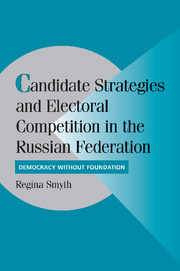 Candidate Strategies and Electoral Competition in the Russian Federation
Candidate Strategies and Electoral Competition in the Russian Federation Book contents
- Frontmatter
- Contents
- 1 ELECTIONS AND THE DEVELOPMENT OF DEMOCRATIC CAPACITY
- 2 ONE STEP FORWARD, TWO STEPS BACK: RUSSIA'S FAILED CONSOLIDATION IN COMPARATIVE CONTEXT
- 3 THE MICROFOUNDATIONS OF DEMOCRATIC RESPONSIVENESS: CANDIDATE STRATEGIES AND ELECTORAL INFRASTRUCTURE
- 4 MANY CANDIDATES, FEW CHOICES
- 5 TO JOIN OR NOT TO JOIN: CANDIDATE AFFILIATION IN TRANSITIONAL RUSSIA
- 6 FINDING FIT: CANDIDATES AND THEIR DISTRICTS
- 7 CAMPAIGNING FOR THE DUMA: MIXED MARKETS, MIXED MESSAGES
- 8 DEMOCRATS, DEMOCRATIC TRANSITIONS, AND RUSSIAN DEMOCRACY
- Appendix A The Sample
- Appendix B The Candidate Survey
- Appendix C Variables Constructed from Survey Data
- Appendix D Sample and Variable Construction for Analysis in Chapter 2
- Works Cited
- Index
- Cambridge Cultural Social Studies
7 - CAMPAIGNING FOR THE DUMA: MIXED MARKETS, MIXED MESSAGES
Published online by Cambridge University Press: 25 July 2009
- Frontmatter
- Contents
- 1 ELECTIONS AND THE DEVELOPMENT OF DEMOCRATIC CAPACITY
- 2 ONE STEP FORWARD, TWO STEPS BACK: RUSSIA'S FAILED CONSOLIDATION IN COMPARATIVE CONTEXT
- 3 THE MICROFOUNDATIONS OF DEMOCRATIC RESPONSIVENESS: CANDIDATE STRATEGIES AND ELECTORAL INFRASTRUCTURE
- 4 MANY CANDIDATES, FEW CHOICES
- 5 TO JOIN OR NOT TO JOIN: CANDIDATE AFFILIATION IN TRANSITIONAL RUSSIA
- 6 FINDING FIT: CANDIDATES AND THEIR DISTRICTS
- 7 CAMPAIGNING FOR THE DUMA: MIXED MARKETS, MIXED MESSAGES
- 8 DEMOCRATS, DEMOCRATIC TRANSITIONS, AND RUSSIAN DEMOCRACY
- Appendix A The Sample
- Appendix B The Candidate Survey
- Appendix C Variables Constructed from Survey Data
- Appendix D Sample and Variable Construction for Analysis in Chapter 2
- Works Cited
- Index
- Cambridge Cultural Social Studies
Summary
During the campaign period, candidates face a final set of decisions to invest in electoral infrastructure. These decisions center on the nature of their appeals to their potential constituents – whether candidates target groups, and whether their campaigns stress issue positions, party platforms, pork, personalized benefits, or their own experiences or character. These decisions have a wide-ranging impact on coordination and cooperation within the constituency. Candidates' campaign strategies can help to identify and forge ties among constituencies or they can further divide or fragment them. Candidates' campaign strategies also shape the information available to voters on election day. They can clearly distinguish themselves from other candidates and explain in detail what they will do in government, or they can blur those distinctions and present voters with very unclear choices. Finally, candidates' appeals can help to define voters' preferences over enduring issues or they can define a referendum that provides little information outside of the current context.
The argument that campaign styles and strategies influence the quality of democracy should not startle anyone. In the United States, a great deal of ink has been used exploring the relationship between negative campaigning and television advertising on citizens' participation rates or attitudes toward the government. In the comparative literature, the debate focuses on the growing use of personalized or leadership appeals to voters rather than strong party platforms and the effect of this change on representation and stability.
- Type
- Chapter
- Information
- Candidate Strategies and Electoral Competition in the Russian FederationDemocracy without Foundation, pp. 165 - 196Publisher: Cambridge University PressPrint publication year: 2006


